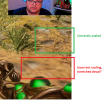Likely the red "light" isn't a light at all, and instead is just an emissive object. This will both tend to produce more noise, and also if the objects are too small they can't be captured very well in some of the Lumen data structures. This is less an issue of RT or not and more an issue of pushing the system too far on the emissive front. This is discussed in the UE documentation and several other sources online; there needs to be a good balance of lighting from analytic sources even if some (ideally larger) emissive objects can contribute as well.
https://docs.unrealengine.com/5.0/en-US/lumen-technical-details-in-unreal-engine/ (search for the various Emissive comments on there)
Thank-you for the explanation, and that makes perfect sense. It was driving me nuts trying to figure out why some scenes (in hindsight, ones completely devoid of emissives) were lit smoothly and well, and others were just awash in noise even at the highest settings. It does look like the developer was just mis-using emissives.
Another issue with this title is that there seems to be no consistency as to how the emissives work. Some of them don't appear to trace against the SDF representation at all, like this one which appears to be screenspace only:
There are also other lighting bugs that don't seem related to emissives, like this one where I'm standing in the exact same spot, my character position isn't moving at all, but when turning the camera only, there's a spot that 'snaps' the nearby objects (the storage cage + biohazard translucent barrier) to nearly fullbright, even though there doesn't appear to be any light source nearby, emissive or otherwise that would cause it to happen.
Moving the character a bit forward or backwards causes that part of the scene to stay dark/shadowed, as looks to be intended, mimicking the other storage cage on the other side.
Some more strangeness about emissives, some have an obvious distance cutoff to its addition to the scene, and that distance cutoff is really close (at the beginning of the below video, the speckled red dots all over the floor.) However, opposite of the screenspace-only emissive in the first video in this post, this one appears to be tracing successfully against the SDF, as the temporally unstable red splotches activate even when the emissive itself is offscreen.
Some other common bugs I noticed were textures not loading in properly, even on a 24GB 3090Ti, 32GB of system ram and a fast PCIe 4.0 NVMe SSD, with VRAM usage never over 10GB. Reminded me of the issues Insomniac had with Spider-man originally. Leaving the room and then coming back in, little chunks of the texture will unload, and others will load, seemingly at random. I spent ten minutes or so spinning around and leaving and re-entering the room, and only once did it appear to load the entire set of textures on the whiteboard. In my video there's one chunk of it, very bottom of the whiteboard in the center that never loads at all.
For all my complaining, I can see the potential in UE5, there are some points in the game, usually when there are zero emissives around, where it truly looks fantastic. Unfortunately in this particular title, that seems to be less than 10% of it. The buggy emissives are everywhere.



